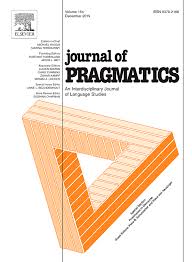永久开放
【限时资源,期刊全文】Journal of Pragmatics《语用学杂志》2019年论文集-共218篇论文(侵删)
1824 阅读 43 下载 2020-06-24 18:14:02 上传 93.41 MB
本期推送的是SSCI期刊——Journal of Pragmatics《语用学杂志》2019年论文集、即第139-154卷共218篇论文,其中目录可在正文中查看,全文可以点击文末附件列表下载,下载链接即日起三天内有效,失效
Journal of Pragmatics《语用学杂志》2019年论文集-共218篇论文(侵删)
资料整理:张明辉(微信:zhangxiaojian160408)
(注意:本资源有两个附件!下载链接三天内有效,失效后请联系小编微信索取)

| 卷号 | 论文号 | 论文题目 |
| Vol. 139 | Article 01 | Risum teneatis, amici?☆: The socio-pragmatics of RoastMe humour |
| Vol. 139 | Article 02 | Metadiscourse: Variation across communicative contexts |
| Vol. 139 | Article 03 | Self-denigration as a relational strategy in lingua franca talk: Asian English speakers |
| Vol. 139 | Article 04 | “You're a nuisance!”: “Patch-up” jocular abuse in Chinese fiction |
| Vol. 139 | Article 05 | Invitations as request-for-service mitigators in academic discourse |
| Vol. 139 | Article 06 | Polyfunction derived from fillers: The case of làmò in Longxi Qiang |
| Vol. 139 | Article 07 | Epistemic commitment and mood alternation: A semantic-pragmatic analysis of Spanish future-framed adverbials |
| Vol. 139 | Article 08 | Managing contingencies in requests: The role of negation in Norwegian interrogative directives |
| Vol. 139 | Article 09 | Multi-party talk in the medical encounter: Socio-pragmatic functions of family members' contributions in the treatment advice phase |
| Vol. 139 | Article 10 | A three-fold approach to the imperative's usage in English and Dutch |
| Vol. 139 | Article 11 | Not hedging but implying: Identifying epistemic implicature through a corpus-driven approach to scientific discourse |
| Vol. 139 | Article 12 | Our alleged methodological flaw |
| Vol. 139 | Article 13 | A methodological flaw? A reply to Korta and Perry |
| Vol. 139 | Article 14 | Our response to Devitt |
| Vol. 139 | Article 15 | Multimodal Metaphor and Metonymy in Advertising, Paula Pérez-Sobrino, Benjamins, Amsterdam (2017), 232 pp (including 25 ads in color). doi: 10.175/ftl.2 ISBN 978-90-272-0986-3 (HB)/978-90-272-6467-1 (E-book), €95 |
| Vol. 139 | Article 16 | Legal Pragmatics, Dennis Kurzon, Barbara Kryk-Kastovsky, John Benjamins Publishing Company, Amsterdam/Philadelphia (2018), 278 pp., ISBN 978-9027200716 (Hardback), EUR 95|USD 143 |
| Vol. 139 | Article 17 | Introduction: Linguistic and discourse issues in contemporary scientific communication. Aspects of communicating science to a variety of audiences |
| Vol. 139 | Article 18 | Discipline and genre in academic discourse: Prepositional Phrases as a focus |
| Vol. 139 | Article 19 | Valuing science: The role of language and body language in a health science lecture |
| Vol. 139 | Article 20 | Scientific writing and the contentfulness of Subject Themes. How science was explained to (lay) audiences |
| Vol. 139 | Article 21 | Knowledge construction in discussions of research articles in two disciplines in Spanish: The role of resources of appraisal |
| Vol. 140 | Article 22 | Between acknowledgement and countering: Interpersonal functions of English reportative adverbs |
| Vol. 140 | Article 23 | Speech acts in professional maritime discourse: A pragmatic risk analysis of bridge team communication directives and commissives in full-mission simulation |
| Vol. 140 | Article 24 | A corpus-driven analysis of certainty stance adverbs: Obviously, really and actually in spoken native and learner English |
| Vol. 140 | Article 25 | Definitely, maybe: A new experimental paradigm for investigating the pragmatics of evidential devices across languages |
| Vol. 140 | Article 26 | Gaze and overlap resolution in triadic interactions |
| Vol. 140 | Article 27 | The aging factor in presupposition processing |
| Vol. 140 | Article 28 | Language workout in bilingual mother-child interaction: A case study of heritage language practices in Russian-Swedish family talk |
| Vol. 140 | Article 29 | Context formulation and the invocation of membership categories in an L2 classroom setting |
| Vol. 140 | Article 30 | Conditionals in therapy and counseling sessions: Therapists' and clients' uses of what-if constructions |
| Vol. 140 | Article 31 | Ethnic identities are low social status identities |
| Vol. 140 | Article 32 | Defining in talk-in-interaction: Recipient-design through negative definitional components |
| Vol. 140 | Article 33 | Impoliteness as a rhetorical strategy in Spain's politics |
| Vol. 140 | Article 34 | Co-occurrence of discourse markers in English: From juxtaposition to composition |
| Vol. 140 | Article 35 | The Semantics of Evidentials, Sarah E. Murray, Oxford University Press, Oxford (2017), (Oxford Studies in Semantics and Pragmatics 9). ISBN 978-0-19-968157-0 (hbk.), 978-0-19-968158-7 (pbk.) 168 pp +Lists of tables, List of figures, List of abbreviations |
| Vol. 141 | Article 36 | What makes a straw man acceptable? Three experiments assessing linguistic factors |
| Vol. 141 | Article 37 | Laughter and its functions in Japanese business communication |
| Vol. 141 | Article 38 | Diving into the wreck: Can people resist allegorical meaning? |
| Vol. 141 | Article 39 | Speech act recognition in Spanish speakers |
| Vol. 141 | Article 40 | A tale of two swamps: Transformations of a metaphorical frame in online partisan media |
| Vol. 141 | Article 41 | Discourse and metadiscourse of Hebrew SOV in the heated parliamentary arena |
| Vol. 141 | Article 42 | Echoic and non-echoic confirming affirmative responses in spoken Brazilian Portuguese |
| Vol. 141 | Article 43 | From digressive marker to topic shifter and beyond. The case of Italian tra parentesi (‘in brackets’) |
| Vol. 141 | Article 44 | Taking the moral high ground: Practices for being uncompromisingly principled |
| Vol. 141 | Article 45 | Turn-peripheral management of Common Ground: A study of Swabian gell |
| Vol. 142 | Article 46 | The pragmatics of air quotes in English academic presentations |
| Vol. 142 | Article 47 | Reference to a past learning event in teacher turns in an L2 instructional setting |
| Vol. 142 | Article 48 | Interviewer effects on the phonetic reduction of negative tags, innit? |
| Vol. 142 | Article 49 | Signing something while meaning its opposite: The expression of irony in Italian Sign Language (LIS) |
| Vol. 142 | Article 50 | Making a glance an action: Doctors' quick looks at their desk-top computer screens |
| Vol. 142 | Article 51 | Indirect requests, relevance, and politeness |
| Vol. 142 | Article 52 | Person reference, identity, and linguistic violence in capital trials |
| Vol. 142 | Article 53 | Discursive construction of “antisocial” institutional conduct: Microanalysis of Takata's failure at the U.S. congressional hearings |
| Vol. 142 | Article 54 | From epistemic modality to concessivity: Alternatives and pragmatic reasoning per absurdum |
| Vol. 142 | Article 55 | Functions and translations of discourse markers in TED Talks: A parallel corpus study of underspecification in five languages |
| Vol. 142 | Article 56 | Stance taking with ‘laugh’ particles and emojis – Sequential and functional patterns of ‘laughter’ in a corpus of German WhatsApp chats |
| Vol. 142 | Article 57 | To stage an overlap – The longitudinal, collaborative and embodied process of staging eight lines in a professional theatre rehearsal process |
| Vol. 142 | Article 58 | Constructing apologies: Reflexive relationships between apologies and offenses |
| Vol. 142 | Article 59 | The Language of Protest: Acts of Performance, Identity and Legitimacy, Mary Lynne Gasaway Hill, Palgrave Macmillan, Cham (2018), ISBN: 978-3-319-77418-3, 317 pages, $109.00 |
| Vol. 142 | Article 60 | Introduction: Strategic uses of politeness formulae. Analytical approaches and theoretical accounts |
| Vol. 142 | Article 61 | “The apology seemed (in)sincere”: Variability in perceptions of (im)politeness |
| Vol. 142 | Article 62 | I'm sorry you are such an arsehole: (non-)canonical apologies and their implications for (im)politeness |
| Vol. 142 | Article 63 | A pragmatic reversal: Italian per favore ‘please’ and its variants between politeness and impoliteness |
| Vol. 142 | Article 64 | Italian scusa from politeness to mock politeness |
| Vol. 142 | Article 65 | ‘Ooh whoops I'm sorry! Teenagers' use of English apology expressions |
| Vol. 142 | Article 66 | The conventionalisation of mock politeness in Chinese and British online forums |
| Vol. 142 | Article 67 | Apologies in French and English: An insight into conventionalisation and im/politeness |
| Vol. 143 | Article 68 | Conceptual mappings in political cartoons: A comparative study of the case of nuclear crises in US–North Korean relations |
| Vol. 143 | Article 69 | The semiotic diversity of doing reference in a deaf signed language |
| Vol. 143 | Article 70 | Talking trolls into existence: On the floor management of trolling in online forums |
| Vol. 143 | Article 71 | Motivations and mechanisms for the development of the reactive what-x construction in spoken dialogue |
| Vol. 143 | Article 72 | Covert negation in Israeli Hebrew: Evidence from co-speech gestures |
| Vol. 143 | Article 73 | “People are people to me”: The interpretation of tautologies with frame-setters |
| Vol. 143 | Article 74 | Emoji and rapport management in Spanish WhatsApp chats |
| Vol. 143 | Article 75 | Interdiscursivity, social media and marketized university discourse: A genre analysis of universities' recruitment posts on WeChat |
| Vol. 143 | Article 76 | Turn allocation within the medical-service-seeking party in Chinese accompanied medical consultations |
| Vol. 143 | Article 77 | “To our great surprise …”: A frame-based analysis of surprise markers in research articles |
| Vol. 143 | Article 78 | Validating common experiences through focus group interaction |
| Vol. 143 | Article 79 | Perceptions of address practices in Italian interregional encounters. A case study of restaurant encounters |
| Vol. 143 | Article 80 | The Evolution of Pragmatic Markers in English. Pathways of Change, Laurel J. Brinton, Cambridge University Press, Cambridge (2017), p. 331, ISBN 978-1-107-12905-4 (£85) Hardback |
| Vol. 143 | Article 81 | Learning pragmatics from native and nonnative language teachers, Andrew D. Cohen, Multilingual Matters, Bristol (2018), 337 pp., ISBN 978-1783099917, USD 49.95 |
| Vol. 143 | Article 82 | Cognitive Pragmatics: Mindreading, Inferences, Consciousness, Marco Mazzone, De Gruyter, Berlin/Boston (2018), 193 pp., ISBN 978-1-5015-1612-2, EUR 99.50 (hardback) |
| Vol. 143 | Article 83 | Style and intersubjectivity in youth interaction, Dwi Noverini Djenar, Michael C. Ewing, Manns Howard, De Gruyter Mouton, Boston/Berlin (2018), p. 255, ISBN 978-1-61451-755-9 |
| Vol. 143 | Article 84 | Methodological insights from ethnomethodology and conversation analysis |
| Vol. 143 | Article 85 | The data and methodology of Harvey Sacks: Lessons from the archive |
| Vol. 143 | Article 86 | The challenges of multimodality and multi-sensoriality: Methodological issues in analyzing tactile signed interaction |
| Vol. 143 | Article 87 | Unpacking and describing interaction on Chinese WeChat: A methodological approach |
| Vol. 143 | Article 88 | Methodology and professional development: Conversation Analytic Role-play Method (CARM) for early childhood education |
| Vol. 143 | Article 89 | Combining analytical tools to inform practice in school-based professional experience |
| Vol. 143 | Article 90 | Analysing atypical interaction: Reflections on the intersection between quantitative and qualitative research |
| Vol. 143 | Article 91 | Conversational lapses and laughter: Towards a combinatorial approach to building collections in conversation analysis |
| Vol. 144 | Article 92 | Interactional competence in L2 text-chat interactions: First-idea proffering in task openings |
| Vol. 144 | Article 93 | ‘On the same page?’ Marginalisation and positioning practices in intercultural teams |
| Vol. 144 | Article 94 | From negation to shared knowledge: The evolution of utterance-final -canha in spoken Korean |
| Vol. 144 | Article 95 | Late Egyptian, Old English and the re-evaluation of Discernment politeness in remote cultures |
| Vol. 144 | Article 96 | Irony, Joana Garmendia, Cambridge University Press, Cambridge (2018), p. 166, ISBN 978-1-107-09263-1 |
| Vol. 144 | Article 97 | Framing, footing, and language scaling practices in children's multilingual peer and sibling-kin group interactions: An introduction |
| Vol. 144 | Article 98 | Negotiating language ideologies through imaginary play: Children's code choice and rescaling practices in Dominica, West Indies |
| Vol. 144 | Article 99 | Playing at being bilingual: Bilingual performances, stance, and language scaling in Mayan Tzotzil siblings' play |
| Vol. 144 | Article 100 | Enregistering Reading and Papá voices in peer bilingual play: Mexican heritage children's scaling practices at a bilingual U.S. preschool |
| Vol. 144 | Article 101 | Stance and footing in multilingual play: Rescaling practices and heritage language use in a Swedish preschool |
| Vol. 144 | Article 102 | Shifting frames: Turkish immigrant children's rescaling practices in two school settings in Arizona |
| Vol. 145 | Article 103 | Editorial: “Quo Vadis, Pragmatics?” |
| Vol. 145 | Article 104 | Pragmatics: Data trends |
| Vol. 145 | Article 105 | Rethinking being Gricean: New challenges for metapragmatics |
| Vol. 145 | Article 106 | Whither historical pragmatics? A cognitively-oriented perspective |
| Vol. 145 | Article 107 | Pragmatics and the challenge of ‘non-propositional’ effects |
| Vol. 145 | Article 108 | Quo vadis pragmatics? From adaptation to participatory sense-making |
| Vol. 145 | Article 109 | Contemporary issues in conversation analysis: Embodiment and materiality, multimodality and multisensoriality in social interaction |
| Vol. 145 | Article 110 | Communicative interaction in terms of ba theory: Towards an innovative approach to language practice |
| Vol. 145 | Article 111 | What if…? Imagining non-Western perspectives on pragmatic theory and practice |
| Vol. 145 | Article 112 | Ethics in pragmatics |
| Vol. 145 | Article 113 | Im/politeness and discursive pragmatics |
| Vol. 145 | Article 114 | Systematic literature reviews: Four applications for interdisciplinary research |
| Vol. 146 | Article 115 | Discourse marker sequences: Insights into the serial order of communicative tasks in real-time turn production |
| Vol. 146 | Article 116 | Reflective practices in Open Dialogue meetings: Reporting and inferential ‘My side tellings’ |
| Vol. 146 | Article 117 | How bad is it to report a slur? An empirical investigation |
| Vol. 146 | Article 118 | Pragmatic development and stay abroad |
| Vol. 146 | Article 119 | Pragmatic gains in the study abroad context: Learners' experiences and recognition of pragmatic routines |
| Vol. 146 | Article 120 | The role of learner status in the acquisition of pragmatic markers during study abroad: The use of ‘like’ in L2 English |
| Vol. 146 | Article 121 | Using corpus-linguistic methods to track longitudinal development: Routine apologies in the study abroad context |
| Vol. 146 | Article 122 | Measuring pragmatic competence on the functional and lexical level: The development of German high-school students' requests during a stay abroad in Canada |
| Vol. 146 | Article 123 | The interaction between duration of study abroad, diversity of loci of learning and sociopragmatic variation patterns: A comparative study |
| Vol. 146 | Article 124 | Pragmatic development of Chinese during study abroad: A cross-sectional study of learner requests |
| Vol. 146 | Article 125 | Initiating and delivering news of the day: Interactional competence as joint-development |
| Vol. 147 | Article 126 | "What did it say?": Mobile phone translation app as participant and object in family discourse |
| Vol. 147 | Article 127 | Turn-sharing revisited: An exploration of simultaneous speech in interactions between couples |
| Vol. 147 | Article 128 | Im/politeness and in/civility: A neglected relationship? |
| Vol. 147 | Article 129 | Instantiation and anchoring: Variation among staking constructions conditioned by non-linguistic practice |
| Vol. 147 | Article 130 | Self-representation in political campaign talk: A functional metadiscourse approach to self-mentions in televised presidential debates |
| Vol. 147 | Article 131 | Irony, Deception, and Humour. Seeking the Truth about Overt and Covert Untruthfulness, Marta Dynel, in: Mouton Series in Pragmatics, 21, De Gruyter Mouton, Boston/Berlin (2018), 487 pp. ISBN 978-1-5015-1642-9, EUR 99, 95 (hardbound). Andreas Stokke, Lying and Insincerity. Oxford University Press, Oxford, 2018, 246 pp. ISBN 978-0-19-882596-8, EUR 51, 00 (hardbound) |
| Vol. 147 | Article 132 | Tag Questions in Conversation. A Typology of their Interactional and Stance Meanings. Ditte Kimps, John Benjamins, Amsterdam/Philadelphia, 250 pp. ISBN 978-9027200433, EUR 99,00 (hardback). |
| Vol. 147 | Article 133 | Review of Socioeconomic Pragmatic Variation. Speech Acts and Address Forms in Context, Larssyn Staley, John Benjamins Publishing Company, Amsterdam/Philadelphia (2018), 201 pp., ISBN 978-90-272-0094-5, EUR 90 (hardback, ebook) |
| Vol. 148 | Article 134 | Level of directness and the use of please in requests in English by native speakers of Arabic and Hebrew |
| Vol. 148 | Article 135 | “It sounds silly now, but it was important then”: Supporting the significance of a personal experience in psychotherapy |
| Vol. 148 | Article 136 | The metapragmatics of Taiwanese (im)politeness: Conceptualization and evaluation of limao |
| Vol. 148 | Article 137 | Delaying moving away: Place, mobility, and the multimodal organization of activities |
| Vol. 148 | Article 138 | Interruptions and co-construction in the First 2016 Trump–Clinton US presidential debate |
| Vol. 148 | Article 139 | Egophoric marking in a sinitic language: The case of baoding |
| Vol. 148 | Article 140 | (Core) common ground and the role of metapragmatic expressions: A comment on Liu and Liu (2017) |
| Vol. 148 | Article 141 | Common ground and metapragmatic expressions in BELF meetings: A response to Zhang and Wu |
| Vol. 148 | Article 142 | (Core) common ground once more: Response to Liu and Liu |
| Vol. 148 | Article 143 | (Studies in Pragmatics, 18.) Beyond Grammaticalization and Discourse Markers. New Issues in the Study of Language Change, Salvador Pons Bordería, Óscar Loureda Lamas (Eds.), Brill, Leiden, Boston (2018), p. 413, EUR €138.00, USD $166.00, Hardback, ISBN: 978-90-04-37540-6 |
| Vol. 149 | Article 144 | Performed retelling: Self-enactment and the dramatisation of narrative on a television talk show |
| Vol. 149 | Article 145 | The users of unparliamentary language in the New Zealand House of Representatives 1890 to 1950: A community of practice perspective |
| Vol. 149 | Article 146 | Hitler's out of Dope: A cross-cultural examination of humorous memes |
| Vol. 149 | Article 147 | An ‘alternative’ core for or |
| Vol. 149 | Article 148 | Negotiating co-participation: Embodied word searching sequences in paired L2 speaking tests |
| Vol. 149 | Article 149 | Metaphor comprehension in L2: Meaning, images and emotions |
| Vol. 149 | Article 150 | Alternating gaze in multi-party storytelling |
| Vol. 149 | Article 151 | Pragmatic trends in French future variant selection |
| Vol. 149 | Article 152 | The Discourse of Online Sportscasting, Book review of Chovanec, Jan, Pragmatics & Beyond New Series, 297 (2018), John Benjamins, Amsterdam, 303 pages. ISBN 9789027201683 |
| Vol. 149 | Article 153 | Language and Television Series. A Linguistic Approach to TV Dialogue, Monika Bednarek, Cambridge University Press, Cambridge (2018), p. 303, pp., ISBN 978-1-108-45915-0, £ 28.99 (paperback) |
| Vol. 149 | Article 154 | The Prosody of Formulaic Sequences: A Corpus and Discourse Approach. Phoebe M.S. Lin, Bloomsbury Academic, London. xii+232, ISBN 978-1-4411-8115-2, EUR 118,35 (hardback). |
| Vol. 150 | Article 155 | Human-human-computer triads in institutional encounters |
| Vol. 150 | Article 156 | Budo demonstrations as shared accomplishments: The modalities of guiding in the joint teaching of physical skills |
| Vol. 150 | Article 157 | Epistemic intonation and epistemic gesture are mutually co-expressive: Empirical results from two intonation-gesture matching tasks |
| Vol. 150 | Article 158 | Inclusive generic person in women's discourse in Israeli Hebrew and Negev Arabic |
| Vol. 150 | Article 159 | Introduction to topicalizing regrading in interaction |
| Vol. 150 | Article 160 | Regrading as a conversational practice |
| Vol. 150 | Article 161 | The interactional dynamics of scaling and contrast in accounts of interpersonal conflict |
| Vol. 150 | Article 162 | Regrading and implicature: Sequential structures of mobility scales in Japanese rehabilitation team interaction |
| Vol. 150 | Article 163 | Scaling as an argumentative resource in television talk shows |
| Vol. 150 | Article 164 | Regrading on and through timescales |
| Vol. 150 | Article 165 | Failed summons: Phonetic features of persistence and intensification in crisis negotiation |
| Vol. 150 | Article 166 | Upgraded self-repeated gestures in Japanese interaction |
| Vol. 151 | Article 167 | Editorial to the special issue “Current developments in intercultural pragmatics” |
| Vol. 151 | Article 168 | “Odd structures” in English as a lingua franca discourse |
| Vol. 151 | Article 169 | Prosodic pragmatics and feedback in intercultural communication |
| Vol. 151 | Article 170 | Metaphors and problematic understanding in chronic care communication |
| Vol. 151 | Article 171 | Skidding on common ground: A socio-cognitive approach to problems in intercultural communicative situations |
| Vol. 151 | Article 172 | German, Spanish and Mandarin speakers' metapragmatic awareness of vague language compared |
| Vol. 151 | Article 173 | Interdisciplinary perspectives on interpersonal relations and the evaluation process: Culture, norms, and the moral order |
| Vol. 151 | Article 174 | Double speech act: Negotiating inter-cultural beliefs and intra-cultural hate speech |
| Vol. 151 | Article 175 | L2 pragmatics as ‘intercultural pragmatics’: Probing sociopragmatic aspects of pragmatic awareness |
| Vol. 151 | Article 176 | “Time is not a line.” Temporal gestures in Chol Mayan |
| Vol. 151 | Article 177 | Beyond answering: Interviewees' use of questions in TV political interviews |
| Vol. 151 | Article 178 | Sparking conversations on Facebook brand pages: Investigating fans' reactions to rhetorical brand posts |
| Vol. 151 | Article 179 | On dynamics of telephone conversation closedown in Farsi |
| Vol. 151 | Article 180 | Mixed Metaphors. Their Use and Abuse, Karen Sullivan, Bloomsbury, London (2018), 229 pp., ISBN 978-1350066052 |
| Vol. 151 | Article 181 | Visual Metaphor: Structure and Process, Gerard J. Steen, John Benjamins Publishing Company, Amsterdam/Philadelphia (2018), 198 pp., ISBN 9789027201515, 90.00 EUR |
| Vol. 151 | Article 182 | The Impulse to Gesture: Where Language, Minds, and Bodies intersect, Simon Harrison, Cambridge University Press, Cambridge (2018), 231 pp., ISBN 978-1-108-41720-4, 96€ |
| Vol. 151 | Article 183 | Historical Pragmatics of Controversies. Case studies from 1600 to 1800, Gerd Fritz, Thomas Gloning, Juliane Glüer, in: Controversies. Ethics and Interdisciplinarity, vol. 14, John Benjamins, Amsterdam/Philadelphia (2018), 346 pp. ISBN 978 90 272 0098 3, EUR 105.00 (hard-bound) |
| Vol. 152 | Article 184 | Understanding the discourse of Chinese civil trials: The perspective of Critical Genre Analysis |
| Vol. 152 | Article 185 | Mimicable embodied demonstration in a decomposed sequence: Two aspects of recipient design in professionals' video-mediated encounters |
| Vol. 152 | Article 186 | Mismatches in the interpretation of fragment negative expressions in Mandarin Chinese |
| Vol. 152 | Article 187 | Meaning-preserving contraposition of natural language conditionals |
| Vol. 152 | Article 188 | Implying identities through narratives of vicarious experience in job interviews |
| Vol. 152 | Article 189 | “Luckily, she's alive”: Narratives of vicarious experience told by Polish doctors |
| Vol. 152 | Article 190 | “It's such a great story it sells itself”? Narratives of vicarious experience in a European pharmaceutical company |
| Vol. 152 | Article 191 | Narratives of vicarious experience in oral history interviews with craft artists |
| Vol. 152 | Article 192 | The family spirit: making sense of organisational internationalisation through founder's stories |
| Vol. 152 | Article 193 | The interplay between humour and identity construction: From humorous identities to identities constructed through humorous practices |
| Vol. 152 | Article 194 | That match was “a bit like losing your virginity”. Failed humour, face and identity construction in TV interviews with professional athletes and coaches |
| Vol. 152 | Article 195 | Contextualizing macro-level identities and constructing inclusiveness through teasing and self-mockery: A view from the intercultural workplace in Japan |
| Vol. 152 | Article 196 | Aggressive humour as a means of voicing customer dissatisfaction and creating in-group identity |
| Vol. 152 | Article 197 | ‘He's got Jheri curls and Tims on’: Humour and indexicality as resources for authentication in young men's talk about hair and fashion style |
| Vol. 152 | Article 198 | Linguistic and ethnic media stereotypes in everyday talk: Humor and identity construction among friends |
| Vol. 152 | Article 199 | An autoethnographic approach to understanding identity construction through the enactment of sense of humor as embodied practice |
| Vol. 152 | Article 200 | Juggling identities in interviews: The metapragmatics of ‘doing humour’ |
| Vol. 153 | Article 201 | Dialogic resources in interactional humour |
| Vol. 153 | Article 202 | Communication styles: Between deliberate strategy and ambivalence |
| Vol. 153 | Article 203 | They are so stupid, so stupid. Emotional affect in Estonian school-related complaints |
| Vol. 153 | Article 204 | I complain, therefore I am: On indirect complaints in Polish |
| Vol. 153 | Article 205 | Estonian declarative questions: Their usage and comparison with vä- and jah-questions |
| Vol. 153 | Article 206 | Declarative questions in Polish student conversations |
| Vol. 153 | Article 207 | The linguistic, conceptual and communicative dimension of metaphor: A corpus study of conversational Polish |
| Vol. 153 | Article 208 | Co-construction of metaphors in Estonian conversation |
| Vol. 153 | Article 209 | The use of positively valued adjectives and adverbs in Polish and Estonian casual conversations |
| Vol. 154 | Article 210 | Non-optimal argumentation: The case of ‘at most’ constructions |
| Vol. 154 | Article 211 | Introduction to prominence in discourse |
| Vol. 154 | Article 212 | On discourse-semantic prominence, syntactic prominence, and prominence of expression: The case of Movima |
| Vol. 154 | Article 213 | Topic chains in dialogues |
| Vol. 154 | Article 214 | Prominence and coherence in a Bayesian theory of pronoun interpretation |
| Vol. 154 | Article 215 | Prominent protagonists |
| Vol. 154 | Article 216 | Enrichment, coherence, and quantifier properties |
| Vol. 154 | Article 217 | Different prominences for different inferences |
| Vol. 154 | Article 218 | Discourse prominence: Definition and application |
所需积分:2 分
永久开放
相关工具
表情
图片
附件















